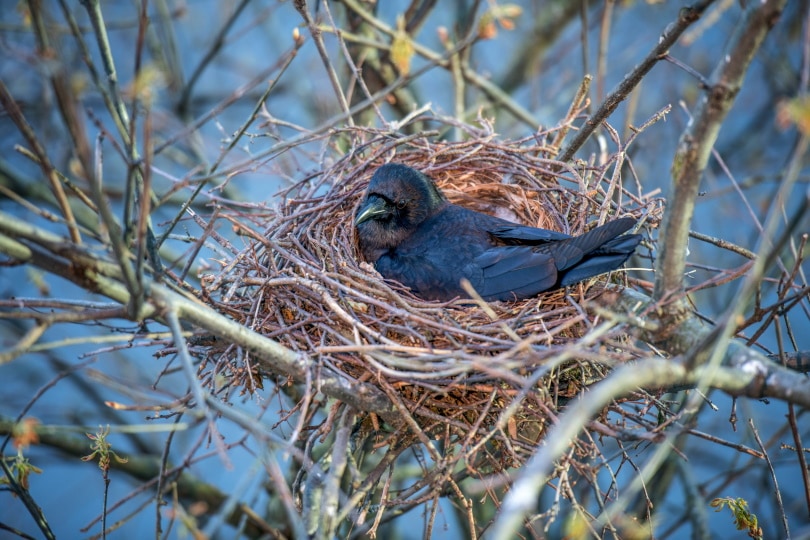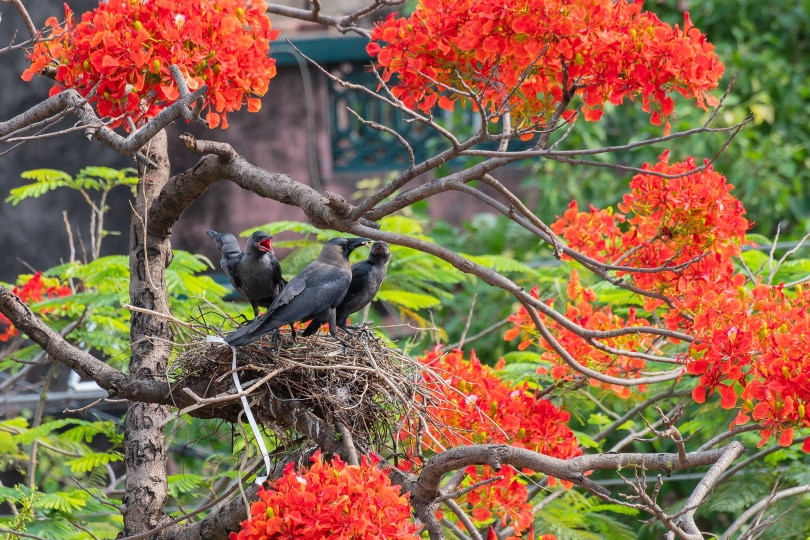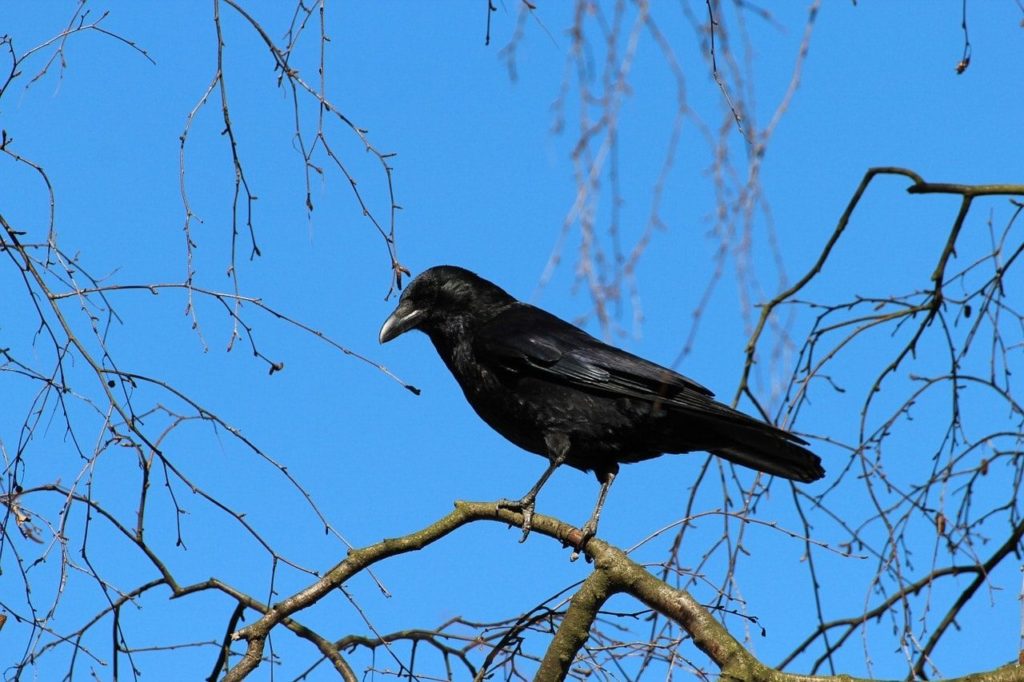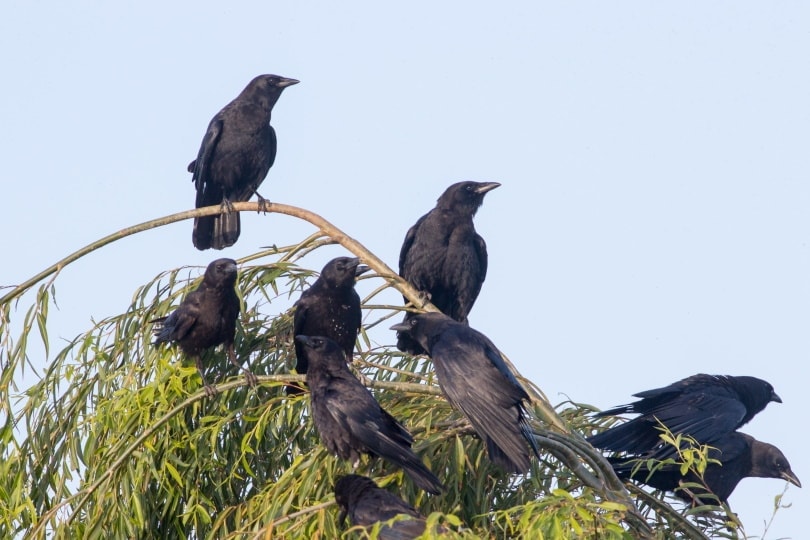Where Do Crows Like to Nest? How Do They Decide?
Last Updated on

Typically, crows prefer to hide their nests in the crotch of a tree, usually near the trunk or a sturdy horizontal branch. They often nest near the top of the tree to keep their nest safe from ground predators. Preferably, they choose evergreen trees that provide continuous shelter. However, they will use a deciduous tree if there are no evergreens available.
Both the male and female will build the nest, usually after they have mated. Even some “helpers1” will get involved in building the nest, which likely provides practice for when the young helpers build their own nests. While nest building is likely instinctual to some degree, it is also possible that young crows practice it with their parents in this manner.
They start with medium-sized twigs, which make up the bulk of the nest. However, the inner part is lined with weeds, soft bark, animal hair, and pine needles. Because these birds prefer evergreen trees, pine needles are one of the most common lining materials.
Usually, they will lay around 3–9 eggs. However, this is highly variable. The eggs are incubated for 16–18 days, and the nestlings stay in the nest for an additional 20–40 days after nesting. Therefore, the parents and babies spend quite a bit of time inside the nest.
After the nest has been used, the crows will usually not return. After the young crows fledge, they will sleep elsewhere. They usually only fledge about one brood per year, though some crows may do two. If trees are sparse, some birds may build a new nest on top of an old one. As you might expect, this is most common in the city where trees are rarer.

What Time of Year Do Crows Have Babies?
Usually, incubation starts somewhere between the end of March and the beginning of June. Therefore, eggs may be present in the nest from the end of March to the end of June, based on the average rate of laying and incubation. After the eggs hatch, it takes another 20–40 days for the babies to leave the nest.
Therefore, birds that are a little late on the spectrum may find themselves nesting for the majority of the summer.
Usually, crows only raise one brood per year. However, in warm places, some crows may fit in two broods if they are quick about it.

Where Do Crows Nest at Night?
If they are currently watching over eggs or baby crows, they will nest near their nesting site. Usually, they will stay here throughout the summer while they are raising their babies. Most crows do not meet up with others to roost in the summer for this reason. They are all too busy raising their babies.
However, once the crows are fledglings, they will start roosting in different places. The primary predator of crows at night is owls so they will typically try to find a location that is safe from these birds. In the city and even some towns, crows may choose to roost in the middle of town where it is bright since it allows them to see and escape owls if necessary.
Most crows will roost communally when they are not nesting. Usually, crows will meet up in groups and then move to a commonly-known nesting site. You may see flocks of crows flying together near the end of the day as they get ready to roost.
These communal roosts are used for many years. Young crows without mates will continue to use them in the summer unless they are staying with their parents as “helpers.” These communal areas allow crows to find mates and exchange information.

Do Crows Return to the Same Nest?
No. Crows will never use the same nest. Instead, they build a new nest every year. However, crows do have a general “territory” that they seem to return to. They will likely roost in the same area, but not in the exact tree.
In places where nesting places are hard to come by, crows may build a new nest on top of their old one. However, this is usually only seen in urban areas and does not seem to be their preference.
Their nests are very sturdy, though. Therefore, they tend to last in the tree for a number of years before they disintegrate. You may see inactive nests in the trees.
Where Do Crows Go During the Day?
If crows are nesting, they will hang around their nest during the day. Typically, they will have to incubate the eggs or feed their hatchlings, so they cannot go very far.
When crows aren’t nesting, they spend the night in communal roosts where they are more protected against owls and other predators. However, during the day, they fly off to their own territories and spend the day foraging. Crows generally stay in “family” groups. Therefore, mated pairs will return to their own territory, but they may be joined by their young children who are called “helpers.”
In all honesty, studies have shown that these helpers may not actually help all that much! However, these young birds may pick up important skills. It is like a practice run in preparation for when they are mated. Because male crows develop slower than females, most of the helpers are males.
It seems that these helpers only really become helpful if one of the parents is injured. In these cases, even the lazier members of the group seem to pick up the slack and help their parents raise the children.
Therefore, birds won’t necessarily return to their own territory. They may actually spend their young lives with their parents during the day. However, most birds do eventually mate and find their own territory. Helpers may inherit territory from their parents, though. So, it is possible that crows may spend their whole lives in the same territory.

Why Do You Never See Baby Crows?
Crows will stay in the nest for the first 20–40 days of their life. They only leave when they become fledglings—at which point they look a lot like adults. It is possible that you have seen baby crows—you just haven’t realized that they are baby crows.
Crows are actually quite large when they become fledglings. Therefore, “baby” does not equal smallness, which may account for why many people think they never see baby crows.
Beyond this, baby crows that have jumped from the nest but cannot fly well are quickly hidden by their parents. Therefore, you likely won’t spot them all that often.
However, you can recognize a baby from an adult by their greyish bill. An adult’s beak is all black, but it takes a little bit for all the pigment to develop. So, a fledgling’s beak is lighter. Their feathers are usually not as black, either. They are more of a matte brown/black and will darken as they get older. Their eyes are also blue like most baby animals.

In Conclusion
Crows prefer to nest in evergreen trees near the trunk. They do nest quite high, which helps keep them safe from predators. They usually use this nest for a single brood, which takes almost all summer to raise. Once the babies grow into fledglings, they will no longer return to the nest.
Crows do not use the same nest over and over again. Each time they lay a clutch, they will build a new nest. This is mostly done by the parents. However, helpers may take part as well. These birds are usually the male offspring of the parents from previous years and perform some amount of labor to help raise the new clutch of babies.
Featured Image Credit: KrisDurlen, Shutterstock
About the Author Kristin Hitchcock
Kristin is passionate about helping animal lovers by informing them on the latest scientific research and understandings. She currently resides in Tennessee with four dogs, three cats, two fish, and a lizard, though she has dreams of owning chickens one day!
Related Articles:
10 Types of Hummingbirds in Arkansas (With Pictures)
8 Types of Hummingbirds in Nebraska (With Pictures)
5 Types of Hummingbirds in Idaho (With Pictures)
3 Types of Hummingbirds in Mississippi (With Pictures)
8 Types of Hummingbirds in Kansas (With Pictures)
5 Types of Hummingbirds in West Virginia (With Pictures)
5 Types of Hummingbirds in Ohio (With Pictures)
Where Do Nuthatches Nest? Nuthatch Nesting Habits Explained
